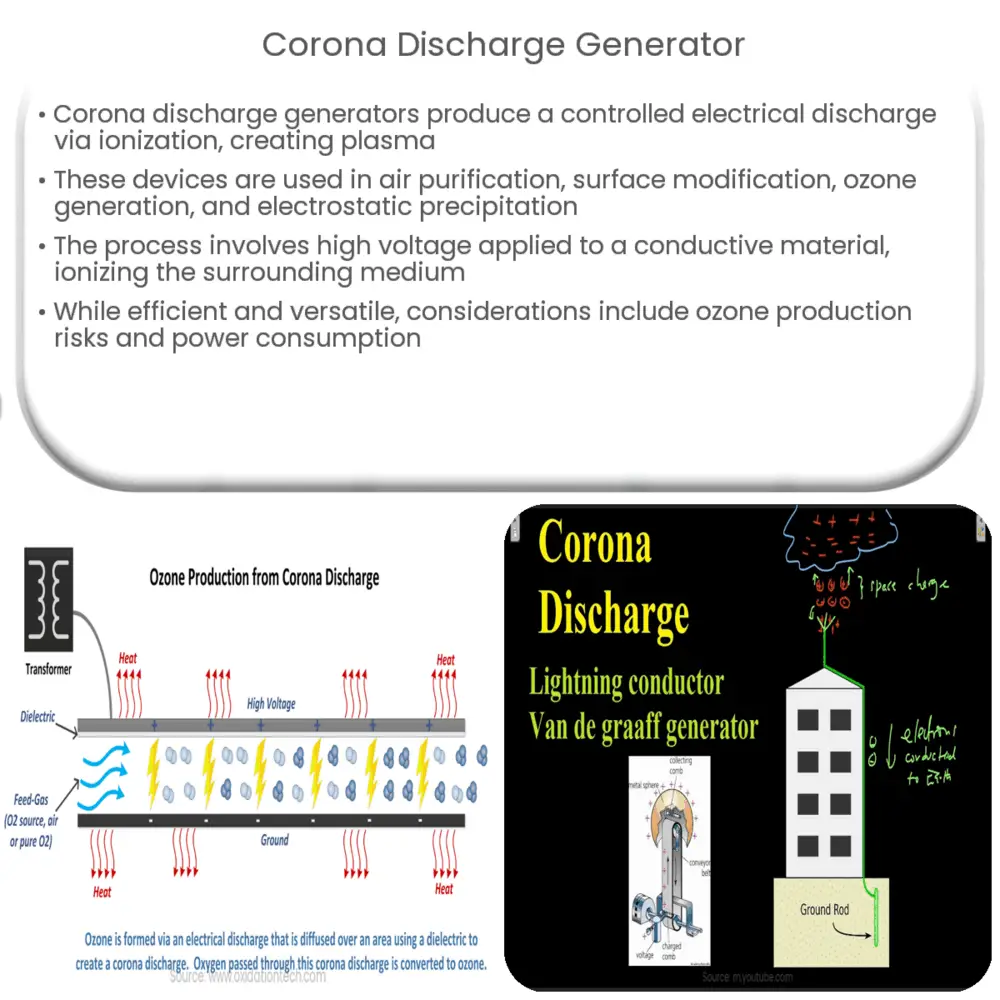Corona discharge generators create controlled electrical discharges, ionizing air to generate plasma, used in air purification, surface modification, and more.

Understanding Corona Discharge Generators
Corona discharge generators are devices that produce a controlled electrical discharge through the ionization of a fluid, typically air, resulting in the generation of a plasma. These generators are used in a variety of applications such as air purification, surface modification, ozone generation, and electrostatic precipitation. This article aims to provide an overview of the principles behind corona discharge generators, their key components, and their applications in different industries.
Principles of Corona Discharge
Corona discharge, also known as the corona effect, is a phenomenon that occurs when a high voltage is applied to a conductive material in the presence of a dielectric medium, usually air. This high voltage causes the air around the conductor to partially ionize, forming a region of plasma. The ionized air, or plasma, emits light, and this is what we see as the visible corona discharge.
The corona discharge process begins when the electric field strength around the conductor exceeds the dielectric breakdown strength of the surrounding medium. At this point, free electrons in the air are accelerated by the electric field, gaining enough energy to ionize other air molecules through collisions. This results in a chain reaction of ionization, creating a plasma that emits light and generates an electrical discharge.
Components of a Corona Discharge Generator
A corona discharge generator typically consists of the following main components:
- High voltage power supply: This provides the necessary voltage to initiate and sustain the corona discharge process. The power supply is usually a high-frequency, high-voltage transformer that can generate voltages in the range of several kilovolts to tens of kilovolts.
- Electrodes: These are the conductive elements that facilitate the generation of the corona discharge. The electrodes are typically made of metal and come in various shapes, such as needles, wires, or plates. The choice of electrode shape depends on the specific application and the desired characteristics of the corona discharge.
- Dielectric medium: This is the insulating material that surrounds the electrodes and helps to confine and shape the corona discharge. The most common dielectric medium is air, but other gases or liquids can also be used, depending on the application.
Applications of Corona Discharge Generators
Corona discharge generators have a wide range of applications in various industries, some of which include:
- Air purification: Corona discharge generators can be used to remove pollutants, odors, and pathogens from the air by generating ozone and other reactive species that oxidize and break down contaminants. This technology is commonly used in air purifiers, HVAC systems, and industrial exhaust systems.
- Surface modification: The reactive species generated by corona discharge can modify the surface properties of materials, such as increasing their wettability, adhesion, or biocompatibility. This is useful in the treatment of plastics, textiles, and other materials for various applications, including printing, painting, and biomedical devices.
Ozone Generation
Ozone generation: Corona discharge is one of the most efficient methods for generating ozone, a powerful oxidizing agent with various industrial and environmental applications. Ozone is produced when oxygen molecules (O2) in the air are ionized and recombine to form ozone molecules (O3). Ozone generators are widely used for water treatment, odor control, food preservation, and other processes that require effective disinfection and oxidation.
Electrostatic Precipitation
Electrostatic precipitation: Corona discharge generators play a crucial role in electrostatic precipitators (ESPs), which are devices used to remove particulate matter from gas streams, such as industrial exhaust or air pollution control systems. The corona discharge imparts a charge to the particles in the gas stream, causing them to be attracted to oppositely charged electrodes, where they are collected and removed from the air. This technology is highly effective at capturing fine particles, making it an essential component of many air pollution control strategies.
Advantages and Limitations
Corona discharge generators offer several advantages, such as:
- High efficiency: Corona discharge is an efficient process for generating reactive species, such as ozone and other oxidizing agents, making it suitable for various applications requiring high levels of oxidation or disinfection.
- Low maintenance: These generators generally have few moving parts, which translates to lower maintenance requirements and longer operational lifetimes compared to other technologies.
- Versatility: Corona discharge generators can be tailored to specific applications by adjusting factors such as electrode geometry, voltage, and dielectric medium, allowing for a wide range of possible uses.
However, there are also some limitations to consider:
- Ozone production: The generation of ozone can be both an advantage and a limitation, depending on the application. Ozone is a powerful oxidizing agent, but it can also be harmful to human health and materials if not properly managed. Proper ventilation and ozone control measures must be taken into account when using corona discharge generators in indoor environments or applications where direct human exposure is possible.
- Power consumption: Corona discharge generators can consume significant amounts of power, especially at high voltages, which can impact the overall energy efficiency and cost-effectiveness of certain applications.
Conclusion
Corona discharge generators offer a versatile and efficient means of generating reactive species for various applications, including air purification, surface modification, ozone generation, and electrostatic precipitation. While there are some limitations to consider, these devices continue to play a vital role in numerous industries and environmental protection efforts. As technology advances and our understanding of corona discharge improves, we can expect even more innovative applications and improvements in the performance of these generators in the future.

